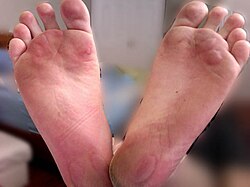Friction blister

Editor-In-Chief: Prab R Tumpati, MD
Obesity, Sleep & Internal medicine
Founder, WikiMD Wellnesspedia &
W8MD medical weight loss NYC and sleep center NYC
| Friction blister | |
|---|---|

| |
| Synonyms | Water blister, friction vesicle |
| Pronounce | N/A |
| Specialty | N/A |
| Symptoms | Fluid-filled vesicle on the skin, pain, redness |
| Complications | Infection, ulceration |
| Onset | Acute |
| Duration | Days to weeks |
| Types | N/A |
| Causes | Friction from rubbing or pressure |
| Risks | Ill-fitting shoes, repetitive motion, moisture |
| Diagnosis | N/A |
| Differential diagnosis | N/A |
| Prevention | Proper footwear, moisture-wicking socks, protective padding |
| Treatment | Drainage, antibiotic ointment, protective dressing |
| Medication | N/A |
| Prognosis | Good with proper care |
| Frequency | Common |
| Deaths | N/A |
Friction Blister
A friction blister is a soft pocket of raised skin filled with clear fluid caused by irritation from continuous rubbing or pressure. Friction blisters usually occur on the hands or feet, where the skin is subjected to persistent rubbing.
Causes[edit]
Friction blisters are caused by three conditions: heat, moisture, and friction on the skin. The most common causes include wearing new or poorly fitting shoes, prolonged walking or running, and performing repetitive motions, such as shoveling or raking.
Symptoms[edit]
The primary symptom of a friction blister is a painful, raised area on the skin filled with fluid. The skin surrounding the blister may be red and swollen.
Treatment[edit]
Treatment for friction blisters focuses on relieving pain and preventing infection. This can be achieved by:
- Cleaning the blister with warm water and gentle soap.
- Applying an over-the-counter antibiotic ointment.
- Covering the blister with a bandage or gauze pad.
- Avoiding popping or draining the blister, as this can lead to infection.
Prevention[edit]
Prevention strategies for friction blisters include:
- Wearing well-fitting shoes and clean, dry socks.
- Using protective pads or bandages in areas prone to friction.
- Taking breaks during repetitive tasks to allow the skin to rest.
See Also[edit]
References[edit]
<references />
Ad. Transform your life with W8MD's Budget GLP-1 injections from $75


W8MD offers a medical weight loss program to lose weight in Philadelphia. Our physician-supervised medical weight loss provides:
- Weight loss injections in NYC (generic and brand names):
- Zepbound / Mounjaro, Wegovy / Ozempic, Saxenda
- Most insurances accepted or discounted self-pay rates. We will obtain insurance prior authorizations if needed.
- Generic GLP1 weight loss injections from $75 for the starting dose.
- Also offer prescription weight loss medications including Phentermine, Qsymia, Diethylpropion, Contrave etc.
NYC weight loss doctor appointmentsNYC weight loss doctor appointments
Start your NYC weight loss journey today at our NYC medical weight loss and Philadelphia medical weight loss clinics.
- Call 718-946-5500 to lose weight in NYC or for medical weight loss in Philadelphia 215-676-2334.
- Tags:NYC medical weight loss, Philadelphia lose weight Zepbound NYC, Budget GLP1 weight loss injections, Wegovy Philadelphia, Wegovy NYC, Philadelphia medical weight loss, Brookly weight loss and Wegovy NYC
|
WikiMD's Wellness Encyclopedia |
| Let Food Be Thy Medicine Medicine Thy Food - Hippocrates |
Medical Disclaimer: WikiMD is not a substitute for professional medical advice. The information on WikiMD is provided as an information resource only, may be incorrect, outdated or misleading, and is not to be used or relied on for any diagnostic or treatment purposes. Please consult your health care provider before making any healthcare decisions or for guidance about a specific medical condition. WikiMD expressly disclaims responsibility, and shall have no liability, for any damages, loss, injury, or liability whatsoever suffered as a result of your reliance on the information contained in this site. By visiting this site you agree to the foregoing terms and conditions, which may from time to time be changed or supplemented by WikiMD. If you do not agree to the foregoing terms and conditions, you should not enter or use this site. See full disclaimer.
Credits:Most images are courtesy of Wikimedia commons, and templates, categories Wikipedia, licensed under CC BY SA or similar.
Translate this page: - East Asian
中文,
日本,
한국어,
South Asian
हिन्दी,
தமிழ்,
తెలుగు,
Urdu,
ಕನ್ನಡ,
Southeast Asian
Indonesian,
Vietnamese,
Thai,
မြန်မာဘာသာ,
বাংলা
European
español,
Deutsch,
français,
Greek,
português do Brasil,
polski,
română,
русский,
Nederlands,
norsk,
svenska,
suomi,
Italian
Middle Eastern & African
عربى,
Turkish,
Persian,
Hebrew,
Afrikaans,
isiZulu,
Kiswahili,
Other
Bulgarian,
Hungarian,
Czech,
Swedish,
മലയാളം,
मराठी,
ਪੰਜਾਬੀ,
ગુજરાતી,
Portuguese,
Ukrainian


